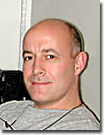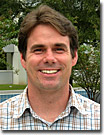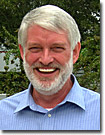Judges 2006

 | Dr. Sue Aicher - An Associate Professor in the Neurological Sciences Institute at the Oregon Health and Science University in Portland, Oregon, Dr. Aicher is focused on investigation of the cellular mechanisms underlying normal and pathophysiological function in both pain and autonomic reflex pathways. Dr. Aicher also serves on the National Institute of Health study section in Confocal Microscopy. Among Dr. Aicher's areas of expertise in optical microscopy are all modes of brightfield (including phase contrast and differential interference contrast), fluorescence, multiphoton, photoactivation and photoconversion, as well as the advanced techniques mentioned above. |
 | Dr. Simon Watkins - A senior faculty member and Director of the Center for Biologic Imaging at the University of Pittsburgh, Dr. Watkins is primarily interested in the development, assembly, and integration of the dystrophin cytoskeleton and its potential role in establishing and maintaining normal muscle function. In addition, Dr. Watkins spearheads the Quantitative Fluorescence Microscopy course held in Mount Desert Island (Salsbury Cove), Maine each summer. Among the many advanced optical microscopy techniques utilized by Dr. Watkins at the Center are laser scanning confocal, live-cell imaging, multiphoton, deconvolution, differential interference contrast, fluorescence recovery after photobleaching (FRAP), fluorescence resonance energy transfer (FRET), spinning disk confocal, laser microdissection, and a variety of techniques applied in digital image processing. Dr. Watkins also has experience with transmission and scanning electron microscopy. Dr. Watkins has been a significant contributor to review articles and Java tutorials on the Olympus optical microscopy educational websites. |
 | Dr. Kenneth N. Fish - An Assistant Professor in the Translational Neuroscience Program in the Department of Psychiatry at the University of Pittsburgh, Dr. Fish uses knockout and genetic mutants that have subtle neuroachitectural abnormalities to study the functional consequences that mispositioning of a subset of neurons during development has on local circuitry. Studies using these mutants may be helpful in understanding aspects of the neuropathology that result in abnormal brain connectivity associated with schizophrenia, autism, and epilepsies. Optical microscopy techniques utilized in this research include confocal and multiphoton fluorescence imaging, as well as total internal reflection fluorescence (TIRFM) along with traditional widefield fluorescence methods. Dr. Fish also has experience with brightfield imaging modes, including phase contrast, differential interference contrast, and oblique illumination. |
 | Dr. Douglas B. Murphy - Professor Murphy is the Director of the optical and electron microscopy laboratory at the new Howard Hughes Medical Institute in Janelia Farm, Virginia. This resource is a core facility that provides equipment and services in fluorescence, confocal, and electron microscopy to laboratories throughout the research campus. Dr. Murphy's research interests include the dependence of microtubules in organelle transport and related microtubule behavior, including polymer annealing and the mechanism of binding microtubule-associated protein (MAP-2) on microtubule surfaces. He has also explored the mechanical and conformational requirements of the motor protein, kinesin. The core facility specializes in advanced fluorescence techniques (FRET, FRAP, TIRFM), confocal, multiphoton, and time-lapse in multiple fluorescence channels. Dr. Murphy has been a significant contributor to review articles and Java tutorials on the Olympus optical microscopy educational websites. |
Not Available in Your Country
Sorry, this page is not
available in your country.